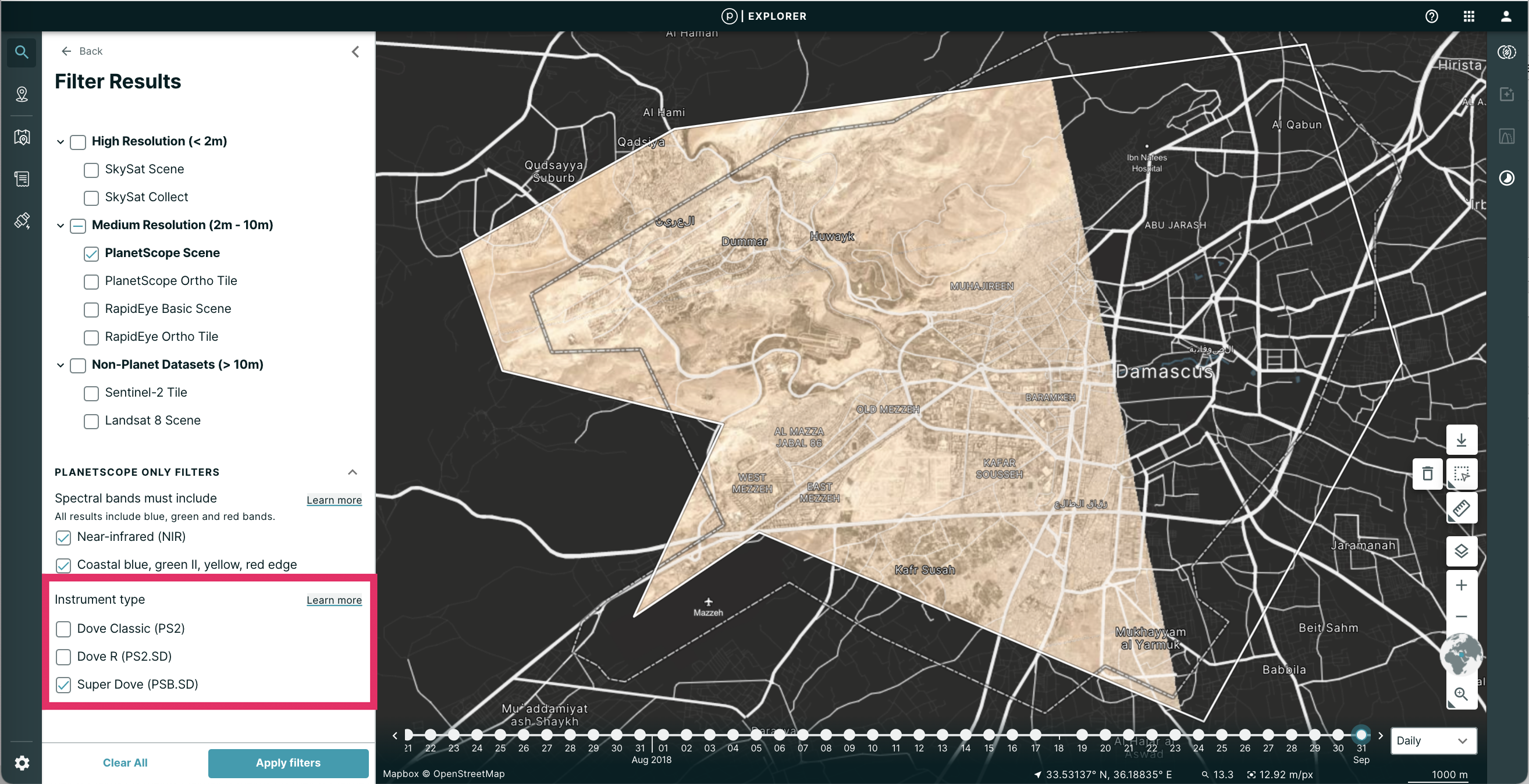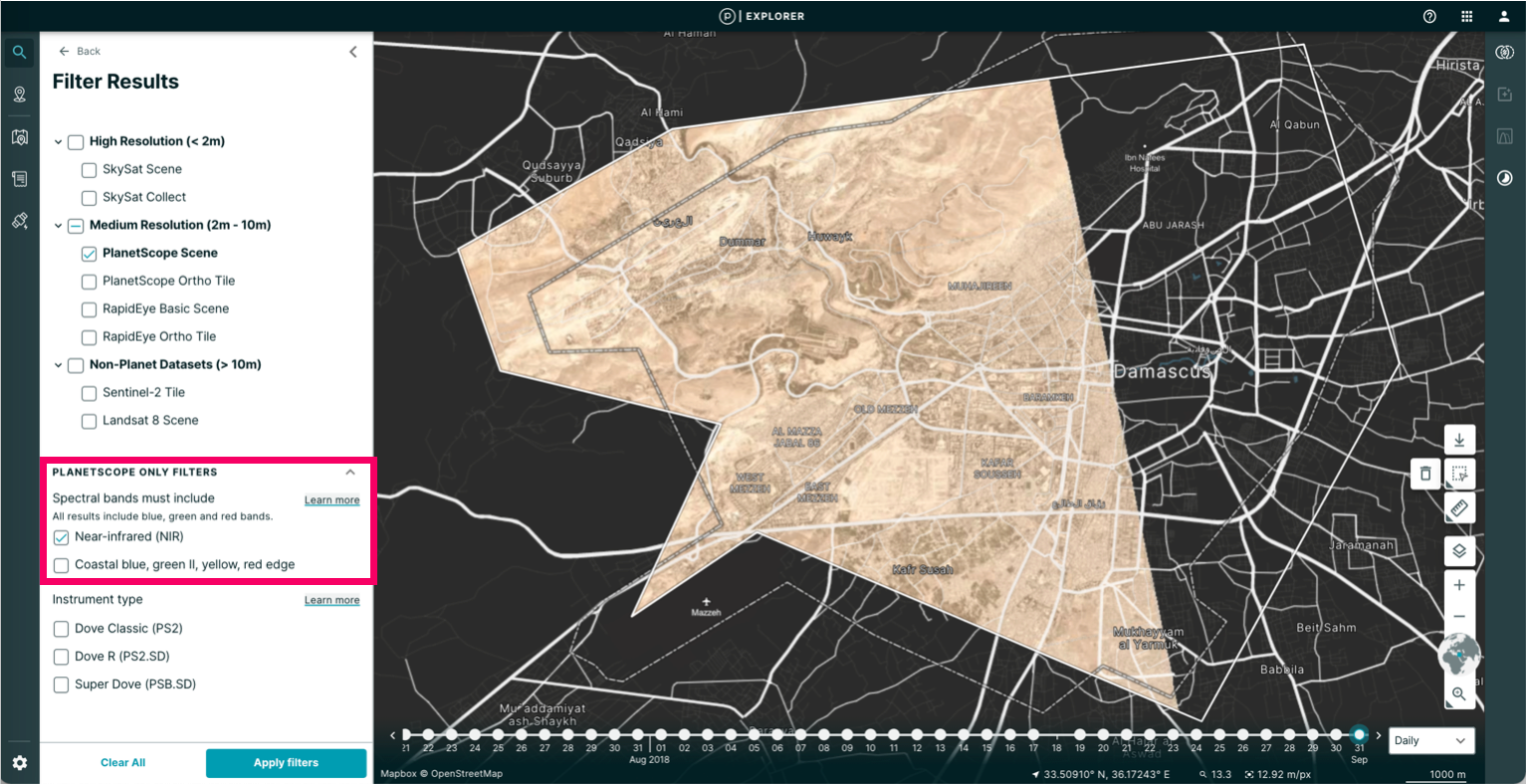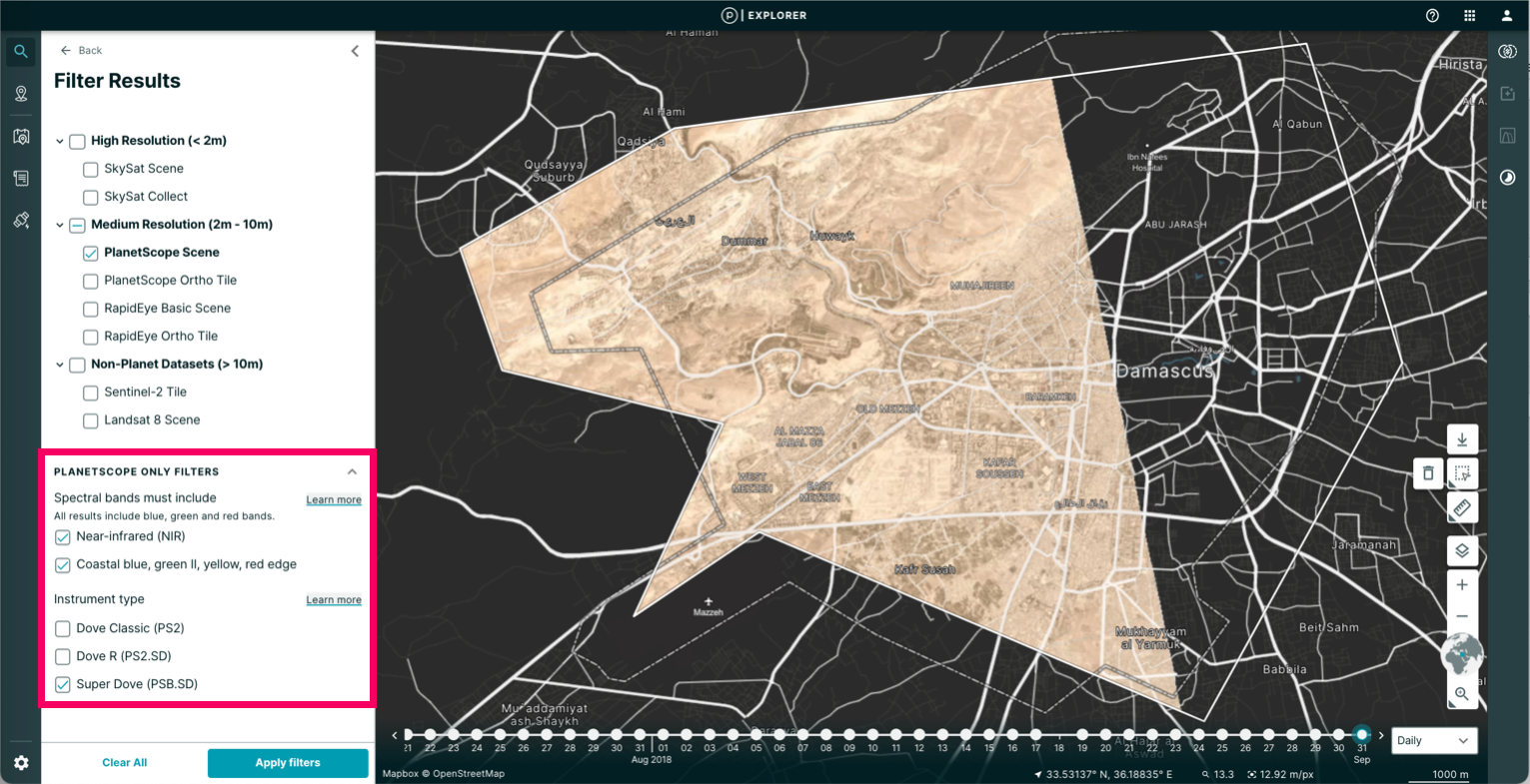Searching for Imagery¶
When do I start consuming tiles?¶
When you log into Planet Explorer, a 2018 Planet Basemap loads as a reference for navigation, which does not consume tiles. You start to consume tiles once you have clicked on an image.
How do I check how much quota I have left in my plan?¶
You can check your tile view quota and how much remaining budget you have from your Planet Account page. Planet recommends that you check at the end of the month to see how much of your quota is used.
When uploading an area of interest (AOI) file, what projection should I use?¶
Projecting data is a key component of successfully combining your data and the imagery found in Planet Explorer. Upload a Shapefile, WKT, GeoJSON, or KML file. Make sure your data is in WGS 84 (SRID/EPSG:4326).
How do I upload files with complicated areas of interest (AOI)?¶
When you import a file and define an area of interest, files with multi-polygons or polygons with over 1500 vertices must be simplified to order imagery. Planet Explorer guides you through the order process so that you can define your area of interest and select which shapes you would like to use for your area of interest. You can can simplify your area of interest by selecting one of the auto-generated options.
Supported file types include shapefile, GeoJSON, JSON, Keyhole Markup Language (KML), Well Known Text (WKT), GPX, DBF, SHX, PRJ, and ZIP files.
What does the error "Invalid Geometry" mean when uploading an AOI file to the Explorer?¶
The error "invalid geometry" means that the projection of your file is not in WGS 84 (commonly referred to as latitude/longitude). The way to fix this error is to re-project your data into WGS 84 (SRID/EPSG: 4326) projection.
How can I find SuperDove imagery?¶
If you would like to view SuperDove imagery, first draw your area of interest. When you see the search panel, click on Filters and select the grouping called Other Attributes. Under Instrument Filter, select PSB.SD as the instrument filter.

Why can’t I find PSScene3Band and PSScene4Band in Explorer anymore?¶
There is a new way to search for PlanetScope Scenes. Now, instead of searching for PSScene3Band or PSScene4Band separately, you can search for PSScene and select the band capabilities you need separately. Band filters include a filter for NIR (“4-band”), as well as Coastal Blue, Green II, Yellow, Red-Edge (“8-band”).
What are the default search filters in Planet Explorer?¶
By default, you will see PlanetScope imagery that has at least NIR capabilities ("4-band"), as this is the most common use case. This includes imagery from Planet’s Dove-Classic, Dove-R, and Super-Dove constellations, but is not inclusive of Planet’s entire archive because some imagery from Dove-Classic does not have NIR capabilities.
Earliest PS2 imagery available on July, 2014 to April 29, 2022. Earliest PS2.SD imagery available is on March, 2019 to April 22, 2022. Earliest PSB.SD imagery available is mid-March, 2020 to current monitoring.

How do I filter results to view only Coastal Blue, Green II, Yellow, Red-Edge capabilities?¶
If you would like to see imagery that has “8-band” capabilities, go to the PlanetScope filters section and select Coastal Blue, Green II, Yellow, Red-Edge. This selection shows imagery captured by our Super-Dove constellations.

How do I filter results to view Planet’s entire PlanetScope archive?¶
Planet Explorer will default to having the NIR band filter selected, to show only imagery that includes NIR capabilities (which is the majority of Planet’s catalog). If you would like to see Planet’s entire PlanetScope catalog, make sure that PSScene is selected under Imagery and unselect the NIR band capability under Planetscope filters. This will be relevant to you if you are looking for older imagery, deep into the archive.

How does searching and filtering impact what I see when I’m ready to order imagery?¶
What you filter on will impact the options you see when ordering. When you are ordering imagery, you will see a menu of available assets based on the capabilities of the imagery you selected; the menu shows only those assets that are in common for all of the imagery that you selected. For example:
- If you filter on PSScene and NIR capabilities, you should expect to see Visual and Surface-Reflectance 4-band assets, with the Surface-Reflectance 4-band asset chosen by default at order time.
- If you filter on PSScene and Coastal Blue, Yellow, Green II capabilities, you should expect to see Visual, Surface-Reflectance 4-band, Surface-Reflectance 8-band, TOAR 4-band, TOAR 8-band assets at order time. The Surface-Reflectance 4-band asset is chosen by default, but you can adjust this according to your use case.
Ordering Hosted Data in Explorer¶
Why do I have to order hosted data to get full bit-depth daily scenes in Explorer? How is that different from what I already see in Explorer?¶
When you order hosted data for analysis in Explorer, it contains information beyond the visual attributes (like spectral bands). We process and host the full-resolution, full bit-depth spectral data upon a customer's request.
These scenes are different from the search results that you preview in Explorer, which is a compressed JPEG that we add to our imagery catalog, for every image we take everyday. We primarily use the JPEG in Explorer so that you can zoom around and view imagery quickly and efficiently, all over the world. If you would like to inspect a specific area, you can order a scene with more capabilities for further analysis.
Can I order any type of scene for analysis in Explorer?¶
Currently, PlanetScope Scenes, RapidEye Orthotile, SkySat Scenes and SkySat Collects are supported. If you order other types of imagery, the order will not go through.
We are not currently supporting Landsat or Sentinel data in this feature.
Does ordering a scene for analysis in Explorer cost money?¶
Yes, customers will be charged quota for ordering hosted data. If you order hosted data and then download the same scene within 30 days, you will only be charged quota one time.
My order for hosted data failed. What should I do?¶
If your order for hosted data fails, try again. If that doesn't work, contact support by submitting a request so that we can troubleshoot. Please make sure to let us know that your order was for hosted data.
Tasking a High-Resolution Image¶
I clicked on the link to task a high-resolution image, but I can't log in. What should I do?¶
If your organization has not purchased a plan to task high-resolution imagery, you will not be able to log in to the Tasking Dashboard. Please contact sales to add this capability to your plan or to learn more.
If your organization has purchased a tasking plan, but you cannot log in, you must request access. Please click Get Help on the Tasking Dashboard login page to be redirected.
We are continually working to improve our technical documentation and support. Please help by sharing your experience with us.